 Technology peripherals
Technology peripherals
 AI
AI
 The inference speed is 2 times faster than Stable Diffusion. Generating and repairing images can be done with one Google model, realizing new SOTA.
The inference speed is 2 times faster than Stable Diffusion. Generating and repairing images can be done with one Google model, realizing new SOTA.
The inference speed is 2 times faster than Stable Diffusion. Generating and repairing images can be done with one Google model, realizing new SOTA.
Text-to-image generation is one of the hottest AIGC directions in 2022 and was selected as one of the top ten scientific breakthroughs in 2022 by "Science". Recently, Google's new text-to-image generation paper "Muse: Text-To-Image Generation via Masked Generative Transformers" has attracted great attention.

- ##Paper address: https://arxiv.org/pdf/2301.00704v1.pdf
- Project address: https://muse-model.github.io/
The study proposes a A new model for text-to-image synthesis using a masked image modeling approach, where the image decoder architecture is conditioned on embeddings from a pre-trained and frozen T5-XXL Large Language Model (LLM) encoder.
Similar to Google’s previous Imagen model, this study found that tuning based on a pre-trained LLM is critical for realistic, high-quality image generation. The Muse model is built on the Transformer (Vaswani et al., 2017) architecture.
Compared with Imagen (Saharia et al., 2022) or Dall-E2 (Ramesh et al., 2022) based on the cascaded pixel-space diffusion model Compared with Muse, the efficiency is significantly improved due to the use of discrete tokens. Compared with the SOTA autoregressive model Parti (Yu et al., 2022), Muse is more efficient due to its use of parallel decoding.
Based on experimental results on TPU-v4, researchers estimate that Muse is more than 10 times faster than Imagen-3B or Parti-3B models in inference speed, and faster than Stable Diffusion v1.4 (Rombach et al., 2022) 2 times faster. Researchers believe that Muse is faster than Stable Diffusion because the diffusion model is used in Stable Diffusion v1.4, which obviously requires more iterations during inference.
On the other hand, the improvement in Muse efficiency has not resulted in a decrease in the quality of the generated images or a decrease in the model's semantic understanding of the input text prompt. This study evaluated Muse's generation results against multiple criteria, including CLIP score (Radford et al., 2021) and FID (Heusel et al., 2017). The Muse-3B model achieved a CLIP score of 0.32 and a FID score of 7.88 on the COCO (Lin et al., 2014) zero-shot validation benchmark.
Let’s take a look at the Muse generation effect:
Text-Image generation: The Muse model quickly generates high-quality images from text prompts (in On TPUv4, it takes 1.3 seconds to generate an image with 512x512 resolution, and 0.5 seconds to generate an image with 256x256 resolution). For example, generate "a bear riding a bicycle and a bird perching on the handlebars":
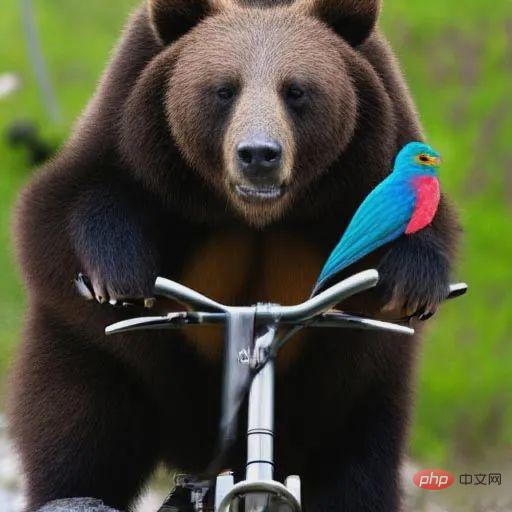
The Muse model generates images under text prompt conditions The token performs iterative resampling, providing users with zero-sample, mask-free editing.
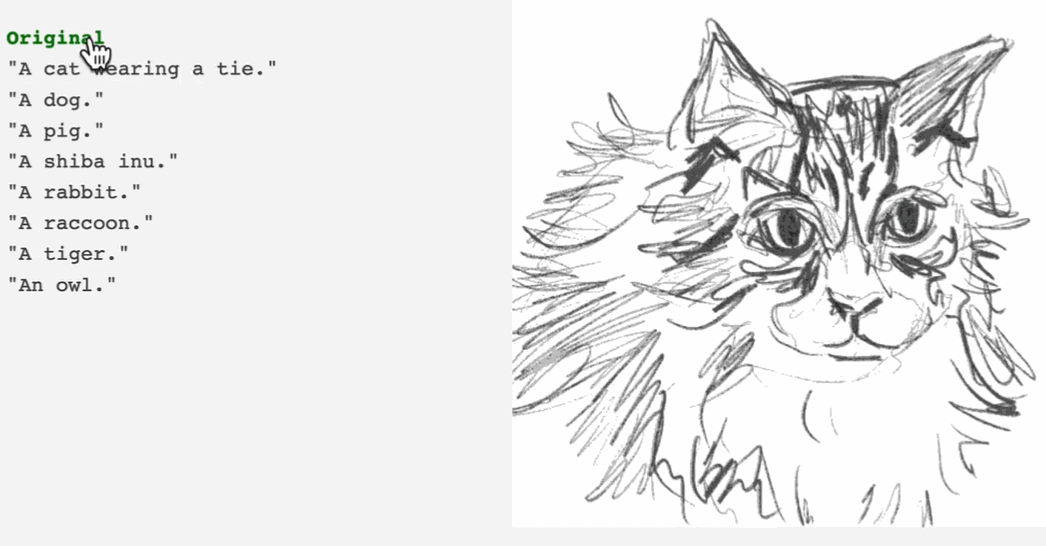
Muse also offers mask-based editing, such as "There is a gazebo on the lake against the backdrop of beautiful autumn leaves."

Muse is built on a number of components, Figure 3 provides an overview of the model architecture.
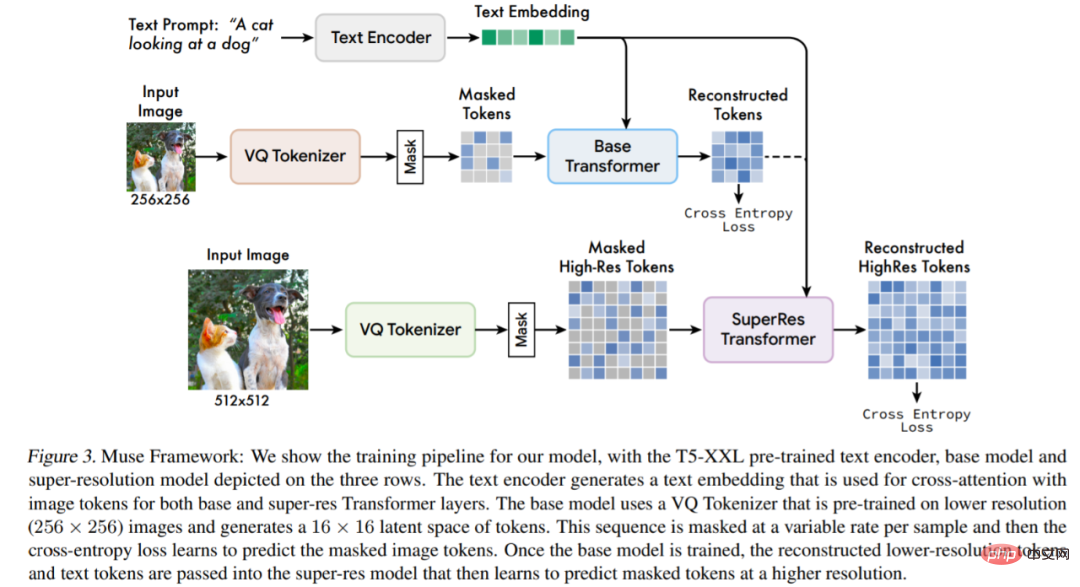
Specifically, the components included are:
Pre-trained text encoder: This study found that utilizing pre-trained large language models (LLM) can improve the quality of image generation. They hypothesized that the Muse model learned to map the rich visual and semantic concepts in the LLM embeddings to the generated images. Given an input text subtitle, the study passes it through a frozen T5-XXL encoder, resulting in a 4096-dimensional sequence of language embedding vectors. These embedding vectors are linearly projected to the Transformer model.
Semantic Tokenization using VQGAN: The core component of this model is the use of semantic tokens obtained from the VQGAN model. Among them, VQGAN consists of an encoder and a decoder, and a quantization layer maps the input image to a token sequence in a learning codebook. This study all uses convolutional layers to build encoders and decoders to support encoding images of different resolutions.
Base model: The base model is a mask transformer where the inputs are embeddings and image tokens projected to T5. The study keeps all text embeddings (unmasked), randomly masks image tokens of different proportions, and replaces them with a special [mask] token.
Super-resolution model: The study found it beneficial to use a cascade of models: first a base model that generates a 16 × 16 latent map (corresponding to a 256 × 256 image), and then The basic latent map is upsampled to the super-resolution model, which is a 64 × 64 latent map (corresponding to a 512 × 512 image).
Decoder fine-tuning: To further improve the model’s ability to generate fine details, this study increases the capacity of the VQGAN decoder by adding more residual layers and channels while maintaining the encoder Capacity remains unchanged. The new decoder layer is then fine-tuned while freezing the VQGAN encoder weights, codebook and transformer (i.e. base model and super-resolution model).
In addition to the above components, Muse also includes variable mask ratio components, iterative parallel decoding components during inference, etc.
Experiments and results
As shown in the table below, Muse shortens the inference time compared with other models.
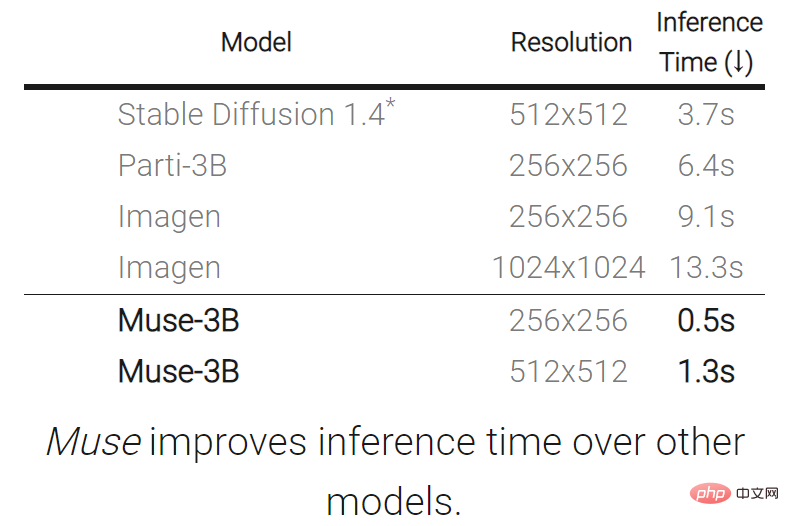
The following table shows the FID and CLIP scores measured by different models on zero-shot COCO:
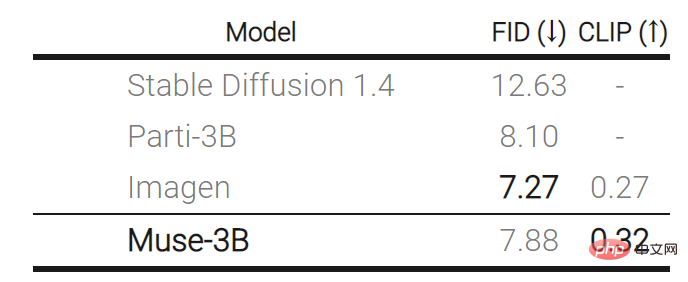
As shown in the table below, Muse (632M (base) 268M (super-res) parameter model) obtained a SOTA FID score of 6.06 when trained and evaluated on the CC3M dataset.
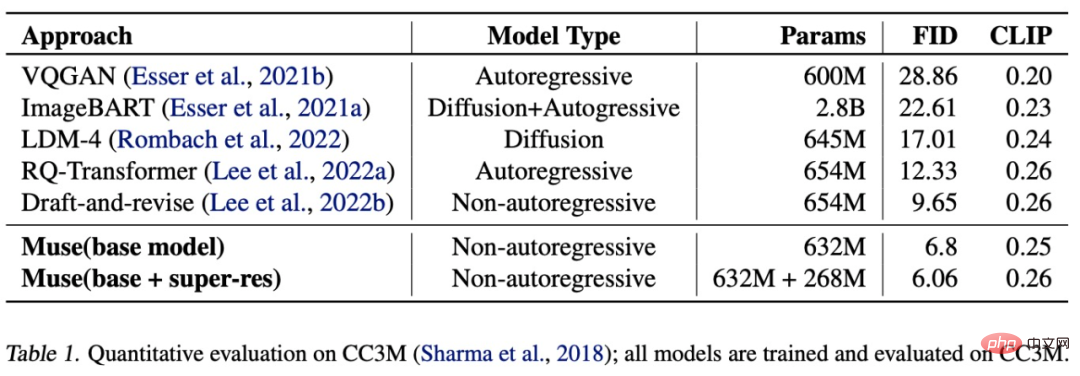
The following figure is an example of results generated by Muse, Imagen, and DALL-E 2 under the same prompt.
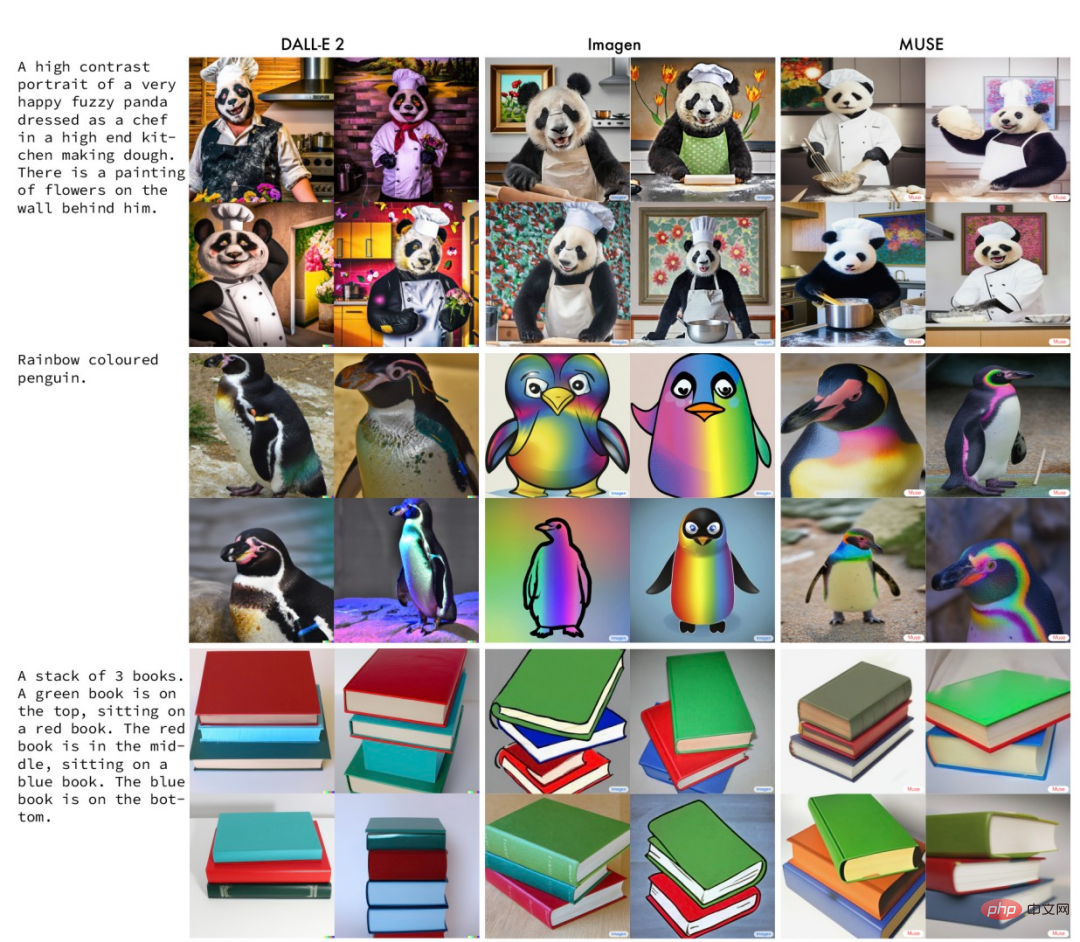
Interested readers can read the original text of the paper to learn more about the research details.
The above is the detailed content of The inference speed is 2 times faster than Stable Diffusion. Generating and repairing images can be done with one Google model, realizing new SOTA.. For more information, please follow other related articles on the PHP Chinese website!

Hot AI Tools

Undresser.AI Undress
AI-powered app for creating realistic nude photos

AI Clothes Remover
Online AI tool for removing clothes from photos.

Undress AI Tool
Undress images for free

Clothoff.io
AI clothes remover

AI Hentai Generator
Generate AI Hentai for free.

Hot Article

Hot Tools

Notepad++7.3.1
Easy-to-use and free code editor

SublimeText3 Chinese version
Chinese version, very easy to use

Zend Studio 13.0.1
Powerful PHP integrated development environment

Dreamweaver CS6
Visual web development tools

SublimeText3 Mac version
God-level code editing software (SublimeText3)

Hot Topics
 1376
1376
 52
52
 The world's most powerful open source MoE model is here, with Chinese capabilities comparable to GPT-4, and the price is only nearly one percent of GPT-4-Turbo
May 07, 2024 pm 04:13 PM
The world's most powerful open source MoE model is here, with Chinese capabilities comparable to GPT-4, and the price is only nearly one percent of GPT-4-Turbo
May 07, 2024 pm 04:13 PM
Imagine an artificial intelligence model that not only has the ability to surpass traditional computing, but also achieves more efficient performance at a lower cost. This is not science fiction, DeepSeek-V2[1], the world’s most powerful open source MoE model is here. DeepSeek-V2 is a powerful mixture of experts (MoE) language model with the characteristics of economical training and efficient inference. It consists of 236B parameters, 21B of which are used to activate each marker. Compared with DeepSeek67B, DeepSeek-V2 has stronger performance, while saving 42.5% of training costs, reducing KV cache by 93.3%, and increasing the maximum generation throughput to 5.76 times. DeepSeek is a company exploring general artificial intelligence
 AI subverts mathematical research! Fields Medal winner and Chinese-American mathematician led 11 top-ranked papers | Liked by Terence Tao
Apr 09, 2024 am 11:52 AM
AI subverts mathematical research! Fields Medal winner and Chinese-American mathematician led 11 top-ranked papers | Liked by Terence Tao
Apr 09, 2024 am 11:52 AM
AI is indeed changing mathematics. Recently, Tao Zhexuan, who has been paying close attention to this issue, forwarded the latest issue of "Bulletin of the American Mathematical Society" (Bulletin of the American Mathematical Society). Focusing on the topic "Will machines change mathematics?", many mathematicians expressed their opinions. The whole process was full of sparks, hardcore and exciting. The author has a strong lineup, including Fields Medal winner Akshay Venkatesh, Chinese mathematician Zheng Lejun, NYU computer scientist Ernest Davis and many other well-known scholars in the industry. The world of AI has changed dramatically. You know, many of these articles were submitted a year ago.
 KAN, which replaces MLP, has been extended to convolution by open source projects
Jun 01, 2024 pm 10:03 PM
KAN, which replaces MLP, has been extended to convolution by open source projects
Jun 01, 2024 pm 10:03 PM
Earlier this month, researchers from MIT and other institutions proposed a very promising alternative to MLP - KAN. KAN outperforms MLP in terms of accuracy and interpretability. And it can outperform MLP running with a larger number of parameters with a very small number of parameters. For example, the authors stated that they used KAN to reproduce DeepMind's results with a smaller network and a higher degree of automation. Specifically, DeepMind's MLP has about 300,000 parameters, while KAN only has about 200 parameters. KAN has a strong mathematical foundation like MLP. MLP is based on the universal approximation theorem, while KAN is based on the Kolmogorov-Arnold representation theorem. As shown in the figure below, KAN has
 Hello, electric Atlas! Boston Dynamics robot comes back to life, 180-degree weird moves scare Musk
Apr 18, 2024 pm 07:58 PM
Hello, electric Atlas! Boston Dynamics robot comes back to life, 180-degree weird moves scare Musk
Apr 18, 2024 pm 07:58 PM
Boston Dynamics Atlas officially enters the era of electric robots! Yesterday, the hydraulic Atlas just "tearfully" withdrew from the stage of history. Today, Boston Dynamics announced that the electric Atlas is on the job. It seems that in the field of commercial humanoid robots, Boston Dynamics is determined to compete with Tesla. After the new video was released, it had already been viewed by more than one million people in just ten hours. The old people leave and new roles appear. This is a historical necessity. There is no doubt that this year is the explosive year of humanoid robots. Netizens commented: The advancement of robots has made this year's opening ceremony look like a human, and the degree of freedom is far greater than that of humans. But is this really not a horror movie? At the beginning of the video, Atlas is lying calmly on the ground, seemingly on his back. What follows is jaw-dropping
 Google is ecstatic: JAX performance surpasses Pytorch and TensorFlow! It may become the fastest choice for GPU inference training
Apr 01, 2024 pm 07:46 PM
Google is ecstatic: JAX performance surpasses Pytorch and TensorFlow! It may become the fastest choice for GPU inference training
Apr 01, 2024 pm 07:46 PM
The performance of JAX, promoted by Google, has surpassed that of Pytorch and TensorFlow in recent benchmark tests, ranking first in 7 indicators. And the test was not done on the TPU with the best JAX performance. Although among developers, Pytorch is still more popular than Tensorflow. But in the future, perhaps more large models will be trained and run based on the JAX platform. Models Recently, the Keras team benchmarked three backends (TensorFlow, JAX, PyTorch) with the native PyTorch implementation and Keras2 with TensorFlow. First, they select a set of mainstream
 Time Series Forecasting NLP Large Model New Work: Automatically Generate Implicit Prompts for Time Series Forecasting
Mar 18, 2024 am 09:20 AM
Time Series Forecasting NLP Large Model New Work: Automatically Generate Implicit Prompts for Time Series Forecasting
Mar 18, 2024 am 09:20 AM
Today I would like to share a recent research work from the University of Connecticut that proposes a method to align time series data with large natural language processing (NLP) models on the latent space to improve the performance of time series forecasting. The key to this method is to use latent spatial hints (prompts) to enhance the accuracy of time series predictions. Paper title: S2IP-LLM: SemanticSpaceInformedPromptLearningwithLLMforTimeSeriesForecasting Download address: https://arxiv.org/pdf/2403.05798v1.pdf 1. Large problem background model
 Tesla robots work in factories, Musk: The degree of freedom of hands will reach 22 this year!
May 06, 2024 pm 04:13 PM
Tesla robots work in factories, Musk: The degree of freedom of hands will reach 22 this year!
May 06, 2024 pm 04:13 PM
The latest video of Tesla's robot Optimus is released, and it can already work in the factory. At normal speed, it sorts batteries (Tesla's 4680 batteries) like this: The official also released what it looks like at 20x speed - on a small "workstation", picking and picking and picking: This time it is released One of the highlights of the video is that Optimus completes this work in the factory, completely autonomously, without human intervention throughout the process. And from the perspective of Optimus, it can also pick up and place the crooked battery, focusing on automatic error correction: Regarding Optimus's hand, NVIDIA scientist Jim Fan gave a high evaluation: Optimus's hand is the world's five-fingered robot. One of the most dexterous. Its hands are not only tactile
 FisheyeDetNet: the first target detection algorithm based on fisheye camera
Apr 26, 2024 am 11:37 AM
FisheyeDetNet: the first target detection algorithm based on fisheye camera
Apr 26, 2024 am 11:37 AM
Target detection is a relatively mature problem in autonomous driving systems, among which pedestrian detection is one of the earliest algorithms to be deployed. Very comprehensive research has been carried out in most papers. However, distance perception using fisheye cameras for surround view is relatively less studied. Due to large radial distortion, standard bounding box representation is difficult to implement in fisheye cameras. To alleviate the above description, we explore extended bounding box, ellipse, and general polygon designs into polar/angular representations and define an instance segmentation mIOU metric to analyze these representations. The proposed model fisheyeDetNet with polygonal shape outperforms other models and simultaneously achieves 49.5% mAP on the Valeo fisheye camera dataset for autonomous driving



